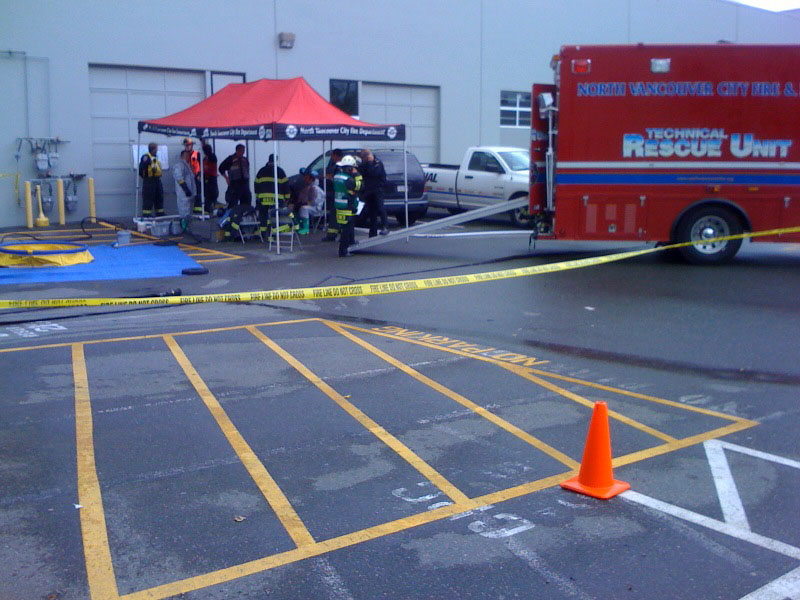CPC FAILS TO RESPOND TO BIOHAZARD INCIDENT – OVER 18 HOURS UNTIL 911 CALLED
Under both the Canada Labour Code and the Collective Agreement, Canada Post is responsible for ensuring that the health and safety of all employees is protected. After a recent incident at the Capilano Delivery Centre in North Vancouver, there is good reason for Canada Post employees to be concerned for their health, safety and general well-being while at work.
 On Monday, May 31, a letter carrier from the Capilano Delivery Centre discovered a powdery yellow substance coating some of the mail while emptying it from a street letter box. It was initially assumed to be a benign substance. The letter carrier became suspicious shortly afterward, however, when a rash developed in the area of contact with the substance. As the mail had already been collected, it was brought back to the Capilano Delivery Centre, and a supervisor was promptly informed.
On Monday, May 31, a letter carrier from the Capilano Delivery Centre discovered a powdery yellow substance coating some of the mail while emptying it from a street letter box. It was initially assumed to be a benign substance. The letter carrier became suspicious shortly afterward, however, when a rash developed in the area of contact with the substance. As the mail had already been collected, it was brought back to the Capilano Delivery Centre, and a supervisor was promptly informed.
The Corporate Manual System (CMS) contains the national procedures for Canada Post – the guidelines that all employees are expected to follow. Management employees have easy access to the CMS and all of its contents, including the procedures and guidelines for a Suspected Biohazard Incident Response (1605.21).
According to these procedures and guidelines, mail items may be considered suspicious if there is “a powdery substance observed on the exterior of the item”.
There is a very clear process to be followed in the event of a suspected biohazard, yet the management team at the Capilano Delivery Centre seemed unsure of exactly what to do. A phone message was left by a supervisor on a non-emergency line at the North Vancouver Fire Department, which turned out to be an administrative phone line, and the message was not retrieved until mid-morning the following day. In the meantime, the contaminated mail was left in a covered flattainer inside the depot overnight. Management allowed the contaminated mail to continue sitting inside the depot the following morning, and an inside worker discovered it and became alarmed. The worker informed a CUPW representative on the workplace health and safety committee, and inquiries were made to management as to how they were handling the situation. It became apparent, however, that management was not handling the situation, and by this time, the inside worker who had discovered the contaminated mail was beginning to experience throat irritation following exposure to it.
Management continued to ignore the potential severity of the situation, and the health and safety of the approximately 180 employees at the Capilano Delivery Centre. It was not until a 911 call was finally made by a CUPW member that the situation was addressed – over 18 hours after the suspicious substance had been brought into the building and management notified. Fire, police and ambulance crews (including Hazmat and Forensic units) arrived at the station within minutes of the call, and began the process of investigating the substance.
The CUPW Vancouver Local is conducting its own investigation. The Union was not notified by the Corporation of this critical incident until almost 24 hours after it was brought to their attention. In total, four employees, including two supervisors, were taken to  the hospital emergency room to be examined following this incident. Initial findings are that the substance was most likely a pesticide or fire retardant. Information provided by the emergency responders suggested that the management team at the Capilano Delivery Centre appeared to have very little knowledge of Canada Post’s procedures and guidelines regarding a suspected biohazard incident. According to the CMS, a drill used to simulate an emergency biohazard response “must be completed at least annually by all employees”.
the hospital emergency room to be examined following this incident. Initial findings are that the substance was most likely a pesticide or fire retardant. Information provided by the emergency responders suggested that the management team at the Capilano Delivery Centre appeared to have very little knowledge of Canada Post’s procedures and guidelines regarding a suspected biohazard incident. According to the CMS, a drill used to simulate an emergency biohazard response “must be completed at least annually by all employees”.
Capilano Delivery Centre Superintendents Macri and Chang appear to have been blissfully ignorant of the need to phone 911 for help. It was left to a CUPW member who, by employing basic common sense, initiated the correct action by making the call.
This incident demonstrates yet again that Canada Post is not committed to the health and safety of its employees. It also makes very clear the fact that we need to know our rights as employees, according to the Canada Labour Code, and the Collective Agreement, and we need to know what Canada Post’s obligations are to us, when it comes to health and safety.
Stay informed. Check out the health and safety bulletin board in your work place. Speak to a CUPW representative on your work place health and safety committee or a shop steward if you are interested in attending a meeting of your work place health and safety committee, or getting more information about health and safety. The full-time officers at the union hall are also available to answer questions and respond to health and safety concerns in your work place.
db/CUPE-3338

